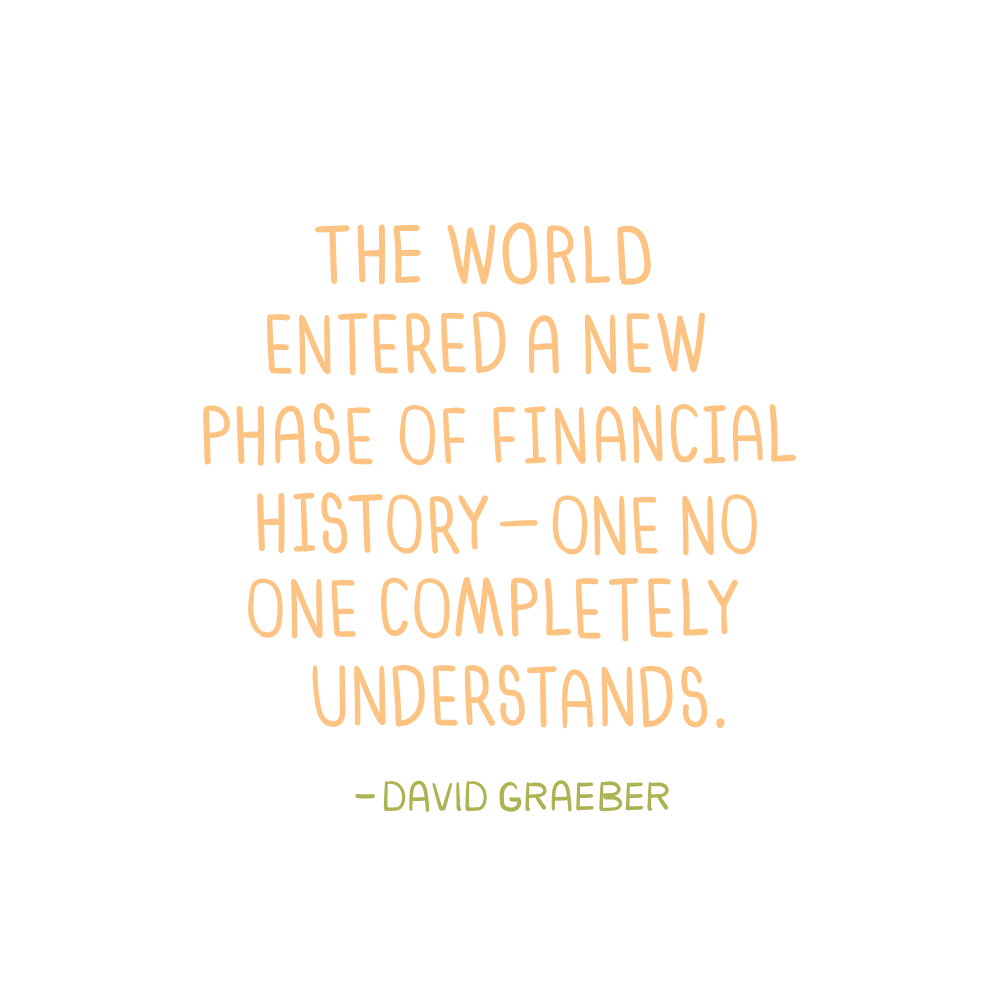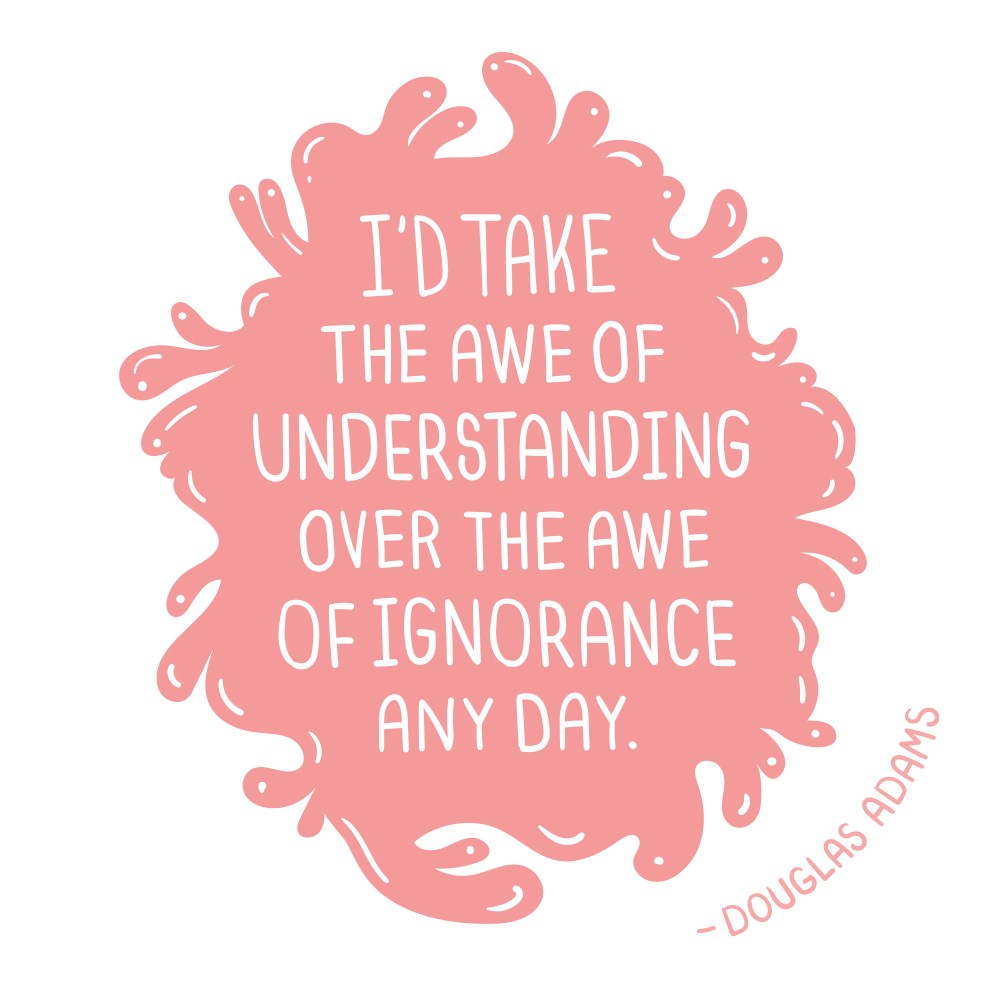The Curious History of Debt
I finally finished reading the 2011 book Debt: The First 5,000 Years by David Graeber. I started reading it LAST AUGUST so, suffice it to say, this 400-page book has been a bit of a slog. But it’s really made me think of a few things I’ve never contemplated before:
The history of money and debt (which is apparently the same story?!?)
Interest rates.
If the mere words “debt”, “money”, and “interest rates” make your eyes goes hazy with boredom—or make you feel silly for not understanding what any of it means—let me take this moment to reassure you: apparently, no one does. Graeber says that since the U.S. dollar was disconnected from the gold standard in the 1970s, “the world entered a new phase of financial history—one no one completely understands.” Well! That’s a… relief?
This is less a blog post about the serious financial world (of which I’ve always suspected was complete bullshit, and know I have indisputable proof that it, in fact, is), and more a blog post that laughs (in a crying sort of way) at the entire ridiculous nature of the economic foundation we’ve built our silly human modern lives upon.
Let’s dig in, shall we?!
Money & Debt
Money and debt are… two sides of the same coin! Sorry, gleeful money metaphor. Or perhaps, more appropriately, money and debt are two halves of the same bank note. Money is debt, and debt is money. Make sense? No? It didn’t for me at first, either.
What I can understand from reading Graeber’s book is that early “money” was basically a simple credit system: in other words, an ongoing tally of both credits and debits (see what I mean about money being a debt?). The most simple modern example I can think of is a bar tab. Rather than using barter (which Gaeber, and apparently all anthropologists everywhere, reject as a complete fairy tale), people pretty much ran the equivalent of a bar tab for everything.
Later on, metal coins and paper money come into production. But even these functioned as more of a symbolic token to mark a credit or debt: “a coin is, effectively, an IOU” (Debt, 46). I was fascinated to learn that paper money started as (and continues to be!) “debt bonds”: IOUs from a government to its taxpayers, mainly to fund military endeavors (Debt, 339). For example: in the 12th Century, the Venetian government force-offered municipal bonds to its taxpaying citizens at 5% interest to fund military pursuits, thus (it seems) inventing paper money (Debt, 338). Modern banking was basically created by the Knights Templar (a Catholic military order) to fund the Crusades (Debt, 291). In 1694, the Bank of England was created to help King William III finance (you guessed it!) a war. The paper money it issued were basically “IOUs” for the King’s war debts, which he owed to the bank’s forty merchant founders (Debt, 339-340).
Okay, brief pause here for a little WTF moment, as I try to put the previous paragraph into as simple, matter-of-fact terms as I can. Basically, there were some self-ordained people who climbed (or murdered) their way to the top of a hill and sing-songed that they were now “King of the Castle” (i.e. “the government”). They looked at another hill and were like, that hill looks juicy, I want that hill too. So they forced the people living on their hill to fight (and die), provide food, weaponry, etc., so the government could have two hills. In payment, the government gave their (largely illiterate) subjects some bits of paper as an IOU. This debt has never been paid off, mainly because new military and war debts are constantly accruing, and hence this money continues to circulate. Cool, cool, cool.
For awhile, coins and paper money were IOUs for the gold which they represented. In other words, when someone was handing you a paper bill they were effectively saying, “I’m paying for this coffee with some gold, but for safety and convenience this gold is hidden under New York City, and this piece of paper with the funny portrait is an IOU for that gold. Trust me on this, and I’d like my latte with caramel drizzle, thank you.”
The bonkers part is that it’s been a literal paper IOU since 1971, when President Nixon severed the tie between the gold standard and the dollar (Debt, 361). So the piece of (practically) worthless paper that has “$20” written on it is NOT backed up or tied to a small piece of gold that we’ve (arbitrarily) decided is worth $20: the piece of paper is backed up by… President Nixon telling us that it’s worth $20??
At first I was like, okay, maybe it’s just kind of bonkers, because before coinage and paper money, we were dealing with a variety of “virtual money” credit systems too, right? So we’ve just cycled back to another virtual credit system. And there’s always had to be some sort of unit of measurement, and now we are just letting the United States decide what that unit is, for the entire world, backed by their military power (Debt, 364-365). WHAT COULD POSSIBLY GO WRONG???
In summary: love this journey for us (visual reference).
Interest Rates
Let’s move on to something just as frustrating – the idea of charging interest (financially known as “usury”)! As someone of European decent, I’m focusing the following paragraphs on the fucked-up history of my own ancestors! Are you ready??
Way back in 1179, the Christian Church felt it was time to clarify, once and for all, that it viewed usury as a “mortal sin” (Debt, 289) … well, a mortal sin for some people. Case-in-point: like I mentioned previously, the Knights Templar (who could be said to have started modern banking) stored wealth, offered credit, and (surprise!) offered mortgages, which (just like the mortgages of today) involved usury (Wikipedia). Eventually we have Martin Luther arguing that 4-5% interest rates are “legal under certain circumstances” (Debt, 322) and in due course, we all merrily skipped along down this slippery slope until interest-bearing loans start becoming common right across Europe (Debt, 333). By 1650, most Christian Protestants think that 5% is just fine for most circumstances, and the Catholics followed quietly behind (Debt, 322) – ah, the Catholic and Protestant Churches! United in their greed.
In 1968 we get modern credit cards (i.e. Visa and Mastercard). 1968! I don’t know why it’s so hard for me to process that my grandparents (in their psychedelic mini-skirts) would have lived in a time before credit cards (although it’s worth mentioning that women couldn’t get credit cards until 1974). At first, interest rates were limited to a max of 7–10% (which, as a reminder, is double the 5% levels that our forefathers thought acceptable). Then, in 1980, the United States Congress eliminates these limitations altogether (Debt, 377) because, why limit your shoulder pad size OR interest rates?? Currently, the average credit card interest rate is almost 16%, which is (fun fact) actually “the lowest it's been since June 2017”. Huh, who is bringing that average down so low, because my BMO credit card charges me an interest rate of 19.99%! Some cards charge as much as 24% interest, with things like Payday Loans charging interest rates of (holy Jeezus) 500-600% (source).
In summary: the Western world used to see charging interest as a crime. Now, not paying morbidly extravagant interest rates makes you the criminal. What a fun little magic trick!
So many questions
So… perhaps you (like me) are asking, as you cry into a bottle of wine, where do we go from here, living as we are in “a world that is nothing more than a series of cold-blooded calculations” (Debt, 387)? I, of course, have no bloody idea. But I do rather like asking questions, such as:
Is charging interest on loans really a job? Like, you’re not creating anything of value: you’re, in fact, not creating anything at all. You’re definitely not helping anyone by charging them exorbitant interest rates. Often these wealthy people loaning their money out didn’t even earn the money that they’re now loaning: they inherited it through their family or are managing it for a corporation. In other words, they came across that money largely by luck. Or perhaps it’s incredibly unlucky, as I think their unsustainable use of this money will have them go down as monstrous destroyers of the world, as we are all forced to constantly produce more and more to keep up with their unsustainable appetite for growth, or risk putting ourselves in debt jail. In summary, even though our governments don’t currently treat these practices as illegal, I fully believe that it’s criminal. Yes, BMO, charging 19.99% interest is criminal. Also, it’s not like a hot potato that you can just throw to the next person. I sometimes think that the adults of the modern world act like 5-year-old children, crying that it’s not their fault and that the corporation made them do it. Phew. Sorry, this first one was more of a rant than a question.
Would things need to change on a global level first, or could we re-think our relationship to money and debt on a small and local community level?
Could we change things on a global level without violence (given that it’s currently held in place by exactly that threat)?
Graeber calls debt “the perversion of a promise” (Debt, 391) – can you make “free promises” in a world where debt (and what is owed) is quantified by someone else?
What would a “free promise” between “free men and women” look like? Can you make a promise to someone you don’t know and don’t trust?
If you didn’t have any debts to pay off (or the constant lurking fear of future debts)… what would you do with your time?
I think I’ll end with a statement that feels perfect for this post, since it’s both comforting and terrifying: “There is very good reason to believe that, in a generation or so, capitalism itself will no longer exist” (Debt, 382).
I wonder if the dinosaurs wrote blog posts like this, predicting their own demise?
DISCLAIMER: This blog post has been based on my own understanding of David Graeber’s book Debt. I wish I could get David Graeber to confirm the accuracy of my above summary (Graeber, if you’re reading this - like, honestly, please let me know). If this post has piqued your interest, I highly recommend that you pick up Graeber’s hefty book and spend (if you’re like me) the better part of a year reading it. There are SO many things I didn’t even get into in this post (like how many ancient debts were literally paid with human flesh across the world, most commonly a selling-your-daughter-into-servitude-until-you-paid-off-your-debt type situation?? Like, actually).







